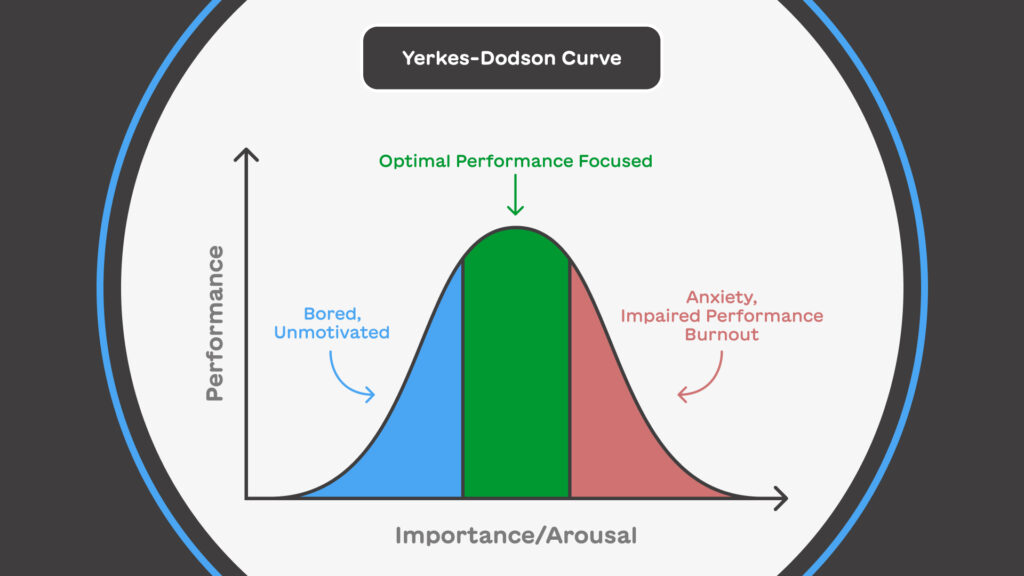Ever wonder why sometimes you're on top of your game and other times you can't seem to get going? The answer could lie in a century-old psychological principle known as the Yerkes-Dodson Law, and it's something we're excited to explore at Innerworld through the Yerkes-Dodson Curve Tool.
What is the Yerkes-Dodson Law?
The Yerkes-Dodson Law reveals an intriguing aspect of human psychology: our performance on tasks is directly related to our levels of arousal or stress. Not enough stress, and we might feel too relaxed to motivate ourselves. Too much, and we're so overwhelmed that our performance suffers. The law suggests there's an optimal level of stress that makes us perform at our best, and this "sweet spot" is what the Yerkes-Dodson Curve illustrates—a bell-shaped curve that helps us visualize how to balance stress and performance.
How the Yerkes-Dodson Curve Tool Helps
This tool isn't just about understanding a psychological principle; it's about applying it to everyday life. It helps us recognize when we're under or over-stimulated and guides us toward the optimal arousal level for peak performance. Whether it's studying for an exam, preparing for a work presentation, or even enhancing our social interactions, understanding where we are on the curve can be transformative.
Examples of the Yerkes-Dodson Curve in Action
Example 1: Ace That Exam
Scenario: You're preparing for a big exam. With little stress, you find it hard to start revising; too much, and you're panicking, unable to focus.
Application: By using the Yerkes-Dodson Curve Tool, you can pinpoint your stress level and adjust it to reach the curve's peak—perhaps by setting small, achievable study goals to moderately increase stress without becoming overwhelmed.
Example 2: Shine in Social Settings
Scenario: You're nervous about attending a social event, fearing you'll either be too anxious to talk to anyone or so relaxed that you might not engage meaningfully.
Application: The tool can help you find a balance. Before the event, engaging in a calming but mentally stimulating activity can raise your arousal to a level that's just right for lively, engaging conversations. If going to an event is overstimulating, you can reduce the weight of the task ahead. For example, you can decide to attend for a limited amount of time or talk intentionally to a certain number of people. Now, instead of your task being “going to an event,” you’ve broken your task down into “go to an event for 30 minutes,” or instead of “talking to people,” your task is now “talking to four people meaningfully.” By chunking out your social tasks, you can give yourself the right amount of mental stimulation to accomplish them.
How to Use the Tool
- Identify a task you’d like to accomplish or a habit you’d like to build. You can think big!
- Use the Yerkes-Dodson Curve to assess how important the task is to you. Does it feel too easy or boring? Overwhelming and difficult? Just right? Mark the x-axis in accordance with your assessment.
- Next, consider the areas on the curve that your mark corresponds to:
- Blue - Perhaps you know this task or habit is important, but it doesn’t feel as important to you as it should. What can you add to the task to arouse your mind a bit more? Does accomplishing the task have long-term benefits? Can it be part of a larger goal?
- Green - Great! You found something that you can sink your teeth into and enjoy.
- Red - This task feels overwhelming and like it’s too much or too big to take on. Try breaking this task up into smaller chunks, and mark each of those on the Yerkes-Dodson Curve. Do the smaller chunks land in the green area? If they do, you’ve now successfully created a series of steps that will help you accomplish a task that once felt too difficult! If they land in the blue, you may be chunking your original task up too much. If they land in red again, try repeating this step.
Why It Works
Understanding and adjusting our stress levels can significantly impact our daily lives. The Yerkes-Dodson Curve Tool empowers us to take control of our performance by finding the right balance of stress. It's about more than just managing stress; it's about harnessing it to enhance our abilities and achieve our goals. Download a worksheet version of the Yerkes-Dodson Curve Tool below for your personal use.
Innerworld offers the unique opportunity to dive deeper into the Yerkes-Dodson Curve and other Cognitive Behavioral Immersion™ tools. By attending our events, you'll not only learn about these principles but also how to apply them in real-life scenarios with the support of our community and trained guides.
Join us at Innerworld to explore how the Yerkes-Dodson Curve Tool can help you optimize your motivation and performance, turning challenges into achievements.

